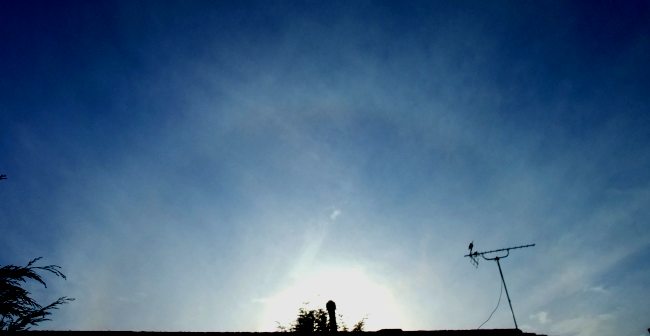Forum Replies Created
-
AuthorPosts
-
Graham Davis
ParticipantAnd here’s a link to a lovely one posted by Asha Santon on uk.sci.weather.
Graham Davis
ParticipantThe graphs look a bit small/unreadable so, if you’re having trouble, have a peek on https://www.flickr.com/photos/scarlet-jade/sets/72157626804420653/with/5817710735/ where they are a bit clearer.
Graham Davis
ParticipantI’ve another graph here which, in addition to the temperature anomaly, shows a sunspot anomaly I calculated, Pacific Decadal Oscillation (PDO) index and the Atlantic Multidecadal Oscillation (AMO).
The broken lines show forecasts of temperature trends. One is based on GS Callendar’s forecast in the 1930’s of a 2C rise for a doubling of CO2 and a second is from 1980 giving a 3C rise. The latter differs from Callendar’s in adding other factors such as water vapour changes to a 2C rise due to CO2. The forecast based on periodic cycles is also from 1980; I suspect that the magnitude of the temperature changes given by this is exaggerated and that only the period of the cycles should be accepted.

You might notice that the post-war dip in temperature corresponds, though with a bit of a lag, with a the post-crash levelling-off of the CO2 curve. The dip in the PDO index after WWII may have contributed to the dip in air temperature but the one just before 1920 occurs after air temperatures had begun a rapid rise. I’m not too sure what to make of the sunspot anomaly either.
Graham Davis
ParticipantHere’s a graph of 12-monthly global temperature anomalies for any interested parties.

Graham Davis
ParticipantHere’s what the BBC said about it a few days ago:
http://www.bbc.co.uk/news/world-asia-china-32006972The following article reports how China how China became top of the league in investment in clean energy last year.
http://www.climatecentral.org/news/u.s.-renewable-investments-climb-18638?utm_source=feedburner&utm_medium=feed&utm_campaign=Feed%3A+ClimateCentral-News+Climate+Central+-+NewsOK, so the first submission of this seems to have gone into a black hole so I’ll have another go.
And another.
Success! Whoopee!
Graham Davis
ParticipantYes, Gini, they all worked for me on Firefox 36.0.1. No idea why “H” is having trouble. Could it be the ISP playing silly beggars on some sites?
Graham Davis
Participant‘H’, thanks for that link. I hadn’t checked ICA Vol 1 so hadn’t spotted that still had Sc cas, shame that Vol 2 doesn’t seem to have a photo.
Not too sure about that photo in the Met Office publication as it could be Ac cas. Ac cas can look a lot lower than it really is because of the larger size of the elements.
I’ve found that Sc cas often makes its appearances in the early morning, shortly after dawn, when I think it may be the remains of cumulus that has formed over the sea but has spread out into Sc when it has moved over the land. In this case, although there is no heat from the surface to maintain convection, there may be processes going on at the cloud level, such as convergence or orograhic lifting, that could kick it off again so that fresh turrets form from the Sc.
Graham Davis
ParticipantWhen I first joined the Met Office (July 1962), the station where I was working had a copy of the ICA that dated from the 1950s. In this, there was a photograph of Stratocumulus castellanus. Later versions of the Atlas have airbrushed that cloud out of existence. I’ve always wondered why this happened as I’ve seen almost as many examples of the cloud as I have of the higher variety.
Graham Davis
ParticipantNacreous clouds are said to form in the stratosphere when temperatures fall below -78C. As one effect of increased CO2 is the cooling of this layer, I think it is possible that Nacreous clouds will become more common. Also, the effect of climate change on the stratosphere is stronger towards the Equator than the Poles, with observed cooling of as much as 8C in the Tropics. This suggests to me that this cloud may become a global feature rather than a largely Polar one.
Graham Davis
ParticipantNorthern lights seen from north Norfolk on the 18th. Quite unusual to see them this far south and also, I understand, the red glow is less common than the green.
http://www.itv.com/news/anglia/update/2015-02-18/your-pictures-of-the-northern-lights-as-seen-in-north-norfolk/Graham Davis
ParticipantThird attempt got closer after editing the HTML link provided by Flickr but no cigar. Also, at least I got a few edits of my reply in before that option vanished. I wonder where it went.
Another go without using [img]

Yeehaa!
Just paste in the HTML link asis, having selected the Flickr “HTML” radio button, without using the CAS [img] button. First of all, however, make sure you have selected the correct size of picture in Flickr (that’s where I went wrong earlier).Graham Davis
ParticipantHere’s my attempt at sharing HTML image from Flickr:
</iframe>” alt=”” />
And the 2nd:
<img src="<img src=”https://farm4.staticflickr.com/3349/5781918860_26f7e51035_s.jpg” width=”75″ height=”75″ alt=”Low cirrus with halo” />” alt=”” />Hmm. If at first you don’t succeed:

Graham Davis
ParticipantI’ve the same trouble. Can’t see any way of changing anything in my profile. I think something is broken.
Graham Davis
ParticipantAnd another lunar-halo photo, this time from Selsey, West Sussex. Also aurora and green-flash photos on the same page:
http://www.spaceweather.com/archive.php?view=1&day=03&month=02&year=2015
Graham Davis
ParticipantI see that a lunar halo was photographed in Colne, Lancashire last night. Here’s the BBC Weather tweet:
https://twitter.com/bbcweather/status/562575712482516992/photo/1 -
AuthorPosts






